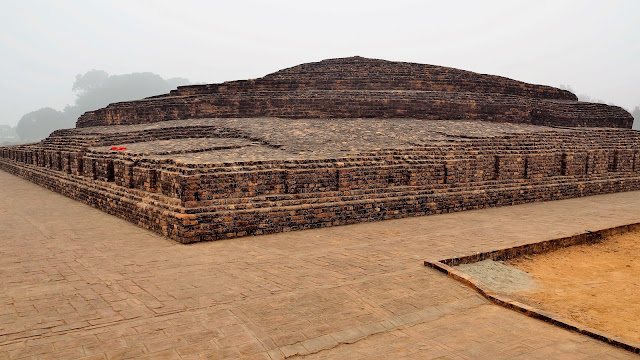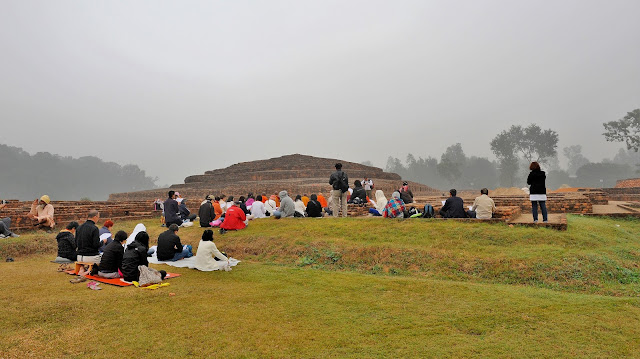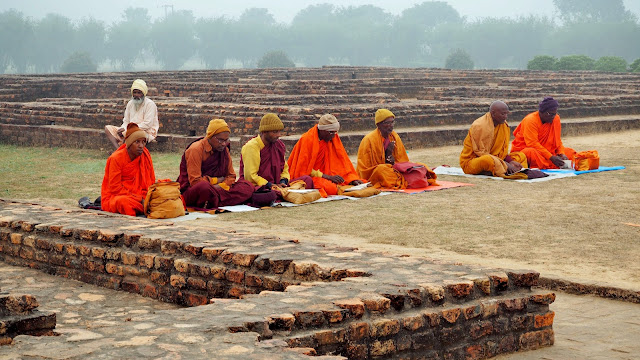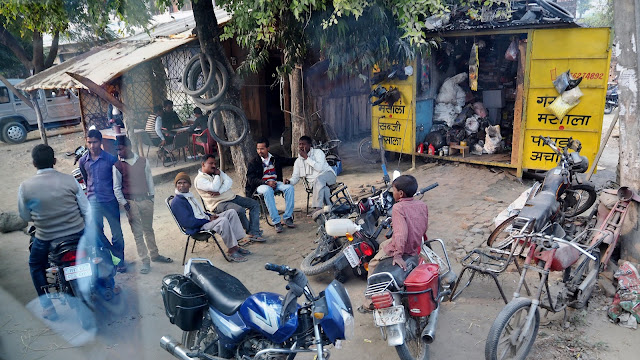BUDDHIST PILGRIMAGE TO INDIA AND NEPAL
“In the Master’s Footsteps” 24 Nov - 5 Dec 2014 (12D/11N)
“In the Master’s Footsteps” 24 Nov - 5 Dec 2014 (12D/11N)

Ching Bee Geok and Ching Neng Bin at ancient Buddhist site, Kapilvastu (Piprahwa) in India.
Day 9 (2.12.2014) - Lumbini to Sravasti in India (250Km 8hrs drive)
Sravasti the place of the Twin Miracle.
The hotel morning call at 4am and breakfast was at 5am. At 6am we departed for Sravasti via Kapilvastu (Piprahwa), which is about 8 hours away. At 10.25am we arrived at Kapilvastu (Piprahwa) in India and at 5pm we arrived at hotel for late lunch. At 5.11pm we stopped by Orajhar in the district of Balrampur and at 5.25pm we visited Kachchi Kuti monument and Pakki Kuti monument also known as Angulimala Cave.
At 6pm we visited the Ananda Bodhi society of India, Nava Jetavan Maha Vihar Ramaya at Shravasti. At 7.30pm we went back to hotel for dinner at 8pm.
The hotel morning call at 4am and breakfast was at 5am. At 6am we departed for Sravasti via Kapilvastu (Piprahwa), which is about 8 hours away. At 10.25am we arrived at Kapilvastu (Piprahwa) in India and at 5pm we arrived at hotel for late lunch. At 5.11pm we stopped by Orajhar in the district of Balrampur and at 5.25pm we visited Kachchi Kuti monument and Pakki Kuti monument also known as Angulimala Cave.
At 6pm we visited the Ananda Bodhi society of India, Nava Jetavan Maha Vihar Ramaya at Shravasti. At 7.30pm we went back to hotel for dinner at 8pm.
Dinner & overnight at Sravasti: Hotel Pawan Palace.

Ancient Buddhist Site, Kapilvastu (Piprahwa) in India.

Kapilvastu (Piprahwa) is the important Buddhist place and is located between two important Buddhist places Lumbini (in Nepal; Birth place of Buddha) & Sravasti (where Buddha spent 27 monsoons of his life).

Kapilavastu is the name of the city where Siddhartha Gautama the Buddha, 563-483 BCE, grew up and lived for the first 29 years of his life before leaving to pursue the spiritual path which led to his enlightenment.

Kapilvastu (Piprahwa) was the capital city of Shakya Republic during the 6th Century BC. The Shakya domain was one of the 16 Mahajanpadas (republics) of 6th century BC (the earliest republics of the world).

Kapilvastu (Piprahwa) was the seat of King Sudhodhana, father of Lord Buddha. Prince Siddhartha, spent most of his early years here. He grew up amidst luxury and was kept away from miseries of life. But one day, having seen the pain of life, he broke out of the luxurious entrapment of his father and renounced all the worldly riches & pleasure, at the age of 29 in search for truth and salvation for which he proceeded to Bodhgaya (Bihar) and revisited it 12 years later, long after he attained Enlightenment. It is believed that Lord Buddha preached "Madhupindika Sutta" in kapilvastu. The site has been excavated during 1971-77, when two mounds were excavated in the vicinity of this area.

Ching Neng Bin at Kapilvastu (Piprahwa) in India.

According to the biography of Siddhartha Gautama from the early Buddhis texts, Suddhodana of Kapilvastu and Maya of Devadaha were prince and princess (later king and queen) while Kapilavastu itself is sometimes referenced as a kingdom or royal city. For the first 20 years of their marriage, they had no children, but then, one night, Maya experienced a vivid dream in which four divine spirits carried her away to a garden where they bathed, anointed, dressed her in white, and bestowed garlands of flowers upon her. A white elephant appeared then in the dream and circled her three times before entering her womb through the right side. Maya awoke the next morning knowing she was pregnant.

As her time to deliver drew closer, in keeping with tradition, she assembled an entourage and set out for her home city of Devadaha. The group stopped at the gardens of Lumbini, located between the two cities and, perhaps, landscaped and cared for by both, so she could bathe and rest. After her bath, Maya stepped from the pond and went into labor, giving birth to her son beneath a Sala tree whose branch she clung to for support. The newborn is said to have stood up as soon as he was born, took seven steps, and announced his arrival as a bringer of peace.

Afterwards, the entourage, seemingly, returned to Kapilavastu where a sage predicted that the young prince would grow up to become a mighty king or great spiritual leader. Seven days after his birth, Maya died and his father, fearing that exposure to this kind of suffering – or any kind – would inspire his son to pursue spirituality instead of politics, decreed that he should never know such pain and took measures to prevent it, quickly marrying Maya's sister, Prajapati, so that his son would have a mother.

Depending on which version of the legend one reads, Suddhodana's plan took the form of surrounding young Siddhartha with luxurious diversions, keeping him constantly occupied with study and pleasures, surrounding his palace with a pleasure compound of a high wall, or all of the above. Siddhartha spent the first 29 years of his life in this paradise, married, and had a son before he was exposed to the suffering of life through the Four Signs – an aged man, a sick man, a dead man, and a spiritual ascetic – when he was out for a ride beyond the walls of Kapilavastu.

The realization that he had been living in a dream world of his father's making, and that he, too, would one day experience sickness, old age, and death made all of his former life intolerable to him. Everything he loved, he realized, would one day be lost and everything he had believed to be true was an illusion. He renounced his position and left Kapilavastu, embracing the path of the spiritual ascetic, until he eventually attained enlightenment and became the Buddha (“the awakened one”). Afterwards, he spent the next 45 years of his life teaching others the means by which they could liberate themselves from illusion and suffering in order to live in peace.

Buddhist monks at Kapilvastu (Piprahwa) in India.

Buddhist monks at Kapilvastu (Piprahwa) in India.

BGF Buddhist devotees and Indian monks at Kapilvastu (Piprahwa) in India.

BGF Buddhist devotees and Indian monks at Kapilvastu (Piprahwa) in India.

BGF Buddhist devotees and Indian monks at Kapilvastu (Piprahwa) in India.

Kapilvastu (Piprahwa) in India.

Kapilvastu (Piprahwa) in India.

BGF Buddhist devotees at Kapilvastu (Piprahwa) in India.

BGF Buddhist devotees at Kapilvastu (Piprahwa) in India.

The country road view from Lumbini to Sravasti in India.

The country road view from Lumbini to Sravasti in India.

The country road view from Lumbini to Sravasti in India.

At 5.11pm we stopped by Orajhar in the district of Balrampur, India.

Orajhar is said to be a monastic complex located on a derelict hill with an unpaved path overgrown with grass and wild bushes. It is said to be the place where Lord Buddha performed Twin Miracle (Yamaka patihariya). It may be identified with the celebrated 'Purvarama' or Eastern Monastery, built by Lady Vishakha as seen by Fa-Hien. Here excavation has revealed a three-fold cultural sequence starting from the Kushan period (1st century AD) followed by Gupta and medieval periods. The Kushan period has revealed the remains of a monastic complex with the usual plan. The Gupta period is witnessed in form of a plinth of a temple that is enclosed by a wall. The medieval period revealed a starlike structure at the top of the Gupta temple.

The country road view to Sravasti in India.

Kachchi Kuti in Maheth situated a few meters south-east of Pakki Kuti.

Kachchi Kuti in Maheth. The ruins of Maheth includes two stupas. One stupa, known as Pakki Kuti, is said to be that of Angulimala while the other, known as Kachchi Kuti, is believed to be that of Sudatta, a disciple of Buddha. Pakki Kuti and Kacchi Kuti were later converted into Brahmanical temples.

Kachchi Kuti, situated a few meters south-east of Pakki Kuti, is the most imposing monuments in the area. Dating from Kushan period, it went through various renovations in later periods. A group of scholars proposes to identify if with the stupa of Sudatta as seen by Chinese pilgrims, but according to another view, a large collection of T.C. plaques showing in high relief scenes from the Ramayana suggests its identification as Brahmanical temple.

The ruins of Kachchi Kuti in Maheth.

The ruins of Kachchi Kuti in Maheth.

Pakki Kuti is one of the largest mounds found in Mahet area. It has been identified as remains of stupa of Angulimala as referred by famous Chinese traveller Fa-hien & Hiuen Tsang & also by Cunningham while some other scholars relate it to the ruins of ‘Hall of Law’, supposed to have been built by Prasenjit in honour of Lord Buddha. The structure has undergone a number of subsequent alterations and additions. It appears to be a terraced stupa built on rectangular plan. The supports and drains were provided to the structure as a preventive measure during the time of excavation. The general layout of the structural remains represents constructional activities of different periods, of which earliest may be assigned to Kushana Period.

Story of Angulimal Daku: Angulimala, whose name means "finger garland", he was a wicked man who harassed the city and country, because he was killing the people and cutting a finger of each person in order to make a garland for the presentation to his Guru Dakshina. He was about to kill his own mother in order to make up the required number of fingers when lord Budha intervened.

Nava Jetavana Maha Vihar Ramaya at Shravasti.

Nava Jetavana Maha Vihar Ramaya at Shravasti. This small Buddhist temple is managed by the Sri Lankan Authorities. Facade of the temple is not attractive but it houses a copper coloured big statue of Buddha. The inside wall are fully painted with mural depicting the life story of Buddha.

Receiving monk's blessing at Nava Jetavana Maha Vihar Ramaya at Shravasti.

Ching Bee Geok receiving monk's blessing at Nava Jetavana Maha Vihar Ramaya at Shravasti.

Receiving monk's blessing at Nava Jetavana Maha Vihar Ramaya at Shravasti.

Receiving monk's blessing at Nava Jetavana Maha Vihar Ramaya at Shravasti.

Lim Ka Tin receiving monk's blessing at Nava Jetavana Maha Vihar Ramaya at Shravasti.

Datuk Seri Victor Wee receiving monk's blessing at Nava Jetavana Maha Vihar Ramaya at Shravasti.

Mike Khaw receiving monk's blessing at Nava Jetavana Maha Vihar Ramaya at Shravasti.

May Soong Sin receiving monk's blessing at Nava Jetavana Maha Vihar Ramaya at Shravasti.

Robert Chong Wei Kuen receiving monk's blessing at Nava Jetavana Maha Vihar Ramaya at Shravasti.

Receiving monk's blessing at Nava Jetavana Maha Vihar Ramaya at Shravasti.

Receiving monk's blessing at Nava Jetavana Maha Vihar Ramaya at Shravasti.

Receiving monk's blessing at Nava Jetavana Maha Vihar Ramaya at Shravasti.

Tan Kim Chan receiving monk's blessing at Nava Jetavana Maha Vihar Ramaya at Shravasti.

Receiving monk's blessing at Nava Jetavana Maha Vihar Ramaya at Shravasti.

Ching Bee Geok receiving monk's blessing at Nava Jetavana Maha Vihar Ramaya at Shravasti.

Receiving monk's blessing at Nava Jetavana Maha Vihar Ramaya at Shravasti.

The country road view to Sravasti in India.

Kachchi Kuti in Maheth situated a few meters south-east of Pakki Kuti.

Kachchi Kuti in Maheth. The ruins of Maheth includes two stupas. One stupa, known as Pakki Kuti, is said to be that of Angulimala while the other, known as Kachchi Kuti, is believed to be that of Sudatta, a disciple of Buddha. Pakki Kuti and Kacchi Kuti were later converted into Brahmanical temples.

Kachchi Kuti, situated a few meters south-east of Pakki Kuti, is the most imposing monuments in the area. Dating from Kushan period, it went through various renovations in later periods. A group of scholars proposes to identify if with the stupa of Sudatta as seen by Chinese pilgrims, but according to another view, a large collection of T.C. plaques showing in high relief scenes from the Ramayana suggests its identification as Brahmanical temple.

The ruins of Kachchi Kuti in Maheth.

The ruins of Kachchi Kuti in Maheth.

Pakki Kuti is one of the largest mounds found in Mahet area. It has been identified as remains of stupa of Angulimala as referred by famous Chinese traveller Fa-hien & Hiuen Tsang & also by Cunningham while some other scholars relate it to the ruins of ‘Hall of Law’, supposed to have been built by Prasenjit in honour of Lord Buddha. The structure has undergone a number of subsequent alterations and additions. It appears to be a terraced stupa built on rectangular plan. The supports and drains were provided to the structure as a preventive measure during the time of excavation. The general layout of the structural remains represents constructional activities of different periods, of which earliest may be assigned to Kushana Period.

Story of Angulimal Daku: Angulimala, whose name means "finger garland", he was a wicked man who harassed the city and country, because he was killing the people and cutting a finger of each person in order to make a garland for the presentation to his Guru Dakshina. He was about to kill his own mother in order to make up the required number of fingers when lord Budha intervened.

Nava Jetavana Maha Vihar Ramaya at Shravasti.

Nava Jetavana Maha Vihar Ramaya at Shravasti. This small Buddhist temple is managed by the Sri Lankan Authorities. Facade of the temple is not attractive but it houses a copper coloured big statue of Buddha. The inside wall are fully painted with mural depicting the life story of Buddha.

Receiving monk's blessing at Nava Jetavana Maha Vihar Ramaya at Shravasti.

Ching Bee Geok receiving monk's blessing at Nava Jetavana Maha Vihar Ramaya at Shravasti.

Receiving monk's blessing at Nava Jetavana Maha Vihar Ramaya at Shravasti.

Receiving monk's blessing at Nava Jetavana Maha Vihar Ramaya at Shravasti.

Lim Ka Tin receiving monk's blessing at Nava Jetavana Maha Vihar Ramaya at Shravasti.

Datuk Seri Victor Wee receiving monk's blessing at Nava Jetavana Maha Vihar Ramaya at Shravasti.

Mike Khaw receiving monk's blessing at Nava Jetavana Maha Vihar Ramaya at Shravasti.

May Soong Sin receiving monk's blessing at Nava Jetavana Maha Vihar Ramaya at Shravasti.

Robert Chong Wei Kuen receiving monk's blessing at Nava Jetavana Maha Vihar Ramaya at Shravasti.

Receiving monk's blessing at Nava Jetavana Maha Vihar Ramaya at Shravasti.

Receiving monk's blessing at Nava Jetavana Maha Vihar Ramaya at Shravasti.

Receiving monk's blessing at Nava Jetavana Maha Vihar Ramaya at Shravasti.

Tan Kim Chan receiving monk's blessing at Nava Jetavana Maha Vihar Ramaya at Shravasti.

Receiving monk's blessing at Nava Jetavana Maha Vihar Ramaya at Shravasti.

Ching Bee Geok receiving monk's blessing at Nava Jetavana Maha Vihar Ramaya at Shravasti.

Receiving monk's blessing at Nava Jetavana Maha Vihar Ramaya at Shravasti.

Ching Neng Bin receiving monk's blessing at Nava Jetavana Maha Vihar Ramaya at Shravasti.

Receiving monk's blessing at Nava Jetavana Maha Vihar Ramaya at Shravasti.
 Receiving monk's blessing at Nava Jetavana Maha Vihar Ramaya at Shravasti.
Receiving monk's blessing at Nava Jetavana Maha Vihar Ramaya at Shravasti.Murals at the Nava Jetavana Temple in Shravasti, India

Mara and his horde attacking Bodhisatta
Visakha directing the construction of the Eastern Monastery in Savatthi
Arahat Cakkhupala, before and after his Blindness
King Pasenadi planting the Ananda Bodhi Tree in Jetavana
Patacara learns about the Sorrows of Existence
Ciñca accuses the Buddha of making her pregnant
Kisa Gotami with her dead child
Rapist dies after attacking Bhikkhuni Uppalavanna
The Buddha praises Daughters to King Pasenadi
Devadatta sinks into the ground
The Buddha and Ananda tend a sick Monk
The Great Emancipation
First Council at Rajagaha
King Asoka at the Third Council
Dinner & overnight at Hotel Pawan Palace in Sravasti.
Day 01 (24.11.2014) Kuala Lumpur to Bangkok to Bodhgaya, India
Day 02 (25.11.2014) Bodhgaya to Dungeswari Cave - Sujata Stupa - Bodhgaya
Day 03 (26.11.2014) Bodhgaya to Rajgir by coach (80km, 3 hrs drive)
Day 04 (27.11.2014) Rajgir to Gijjhakuta Hill (Vulture Peak) - Nalanda - Rajgir
Day 05 (28.11.2014) Rajgir to Vaishali by coach (130km, 5 hrs drive)
Day 06 (29.11.2014) Vaishali to Kushinagar by coach (180km, 6hrs drive)
Day 07 (30.11.2014) Kushinagar to Lumbini by coach (160km, 7hrs drive)
Day 08 (01.12.2014) Lumbini in, Nepal
Day 09 (02.12.2014) Lumbini to Sravasti by coach (250Km, 8hrs drive)
Day 10 (03.12.2014) Sravasti to Varanasi by coach (270Km, 11 hrs. drive)
Day 11 (04.12.2014) Varanasi to Sarnath. Varanasi to Bangkok TG328 16:30hrs 21:15hrs
Day 12 (05.12.2014) Bangkok to Kuala Lumpur
///


Ching, Thanks for sharing. Very comprehensive documentation. I feel as though I've joined your group too. Looking forward to more posts from you. Thanks again. Cheerios, Christine.
ReplyDeleteHello there
ReplyDeleteWe haven't formally met before but I do really enjoy your blogs and photos, great work! Please keep me on your mailing list, very nice.
Warm regards,
Sherina (Datin Ranee Balaratnam's daughter)
Thanks bro Ching for the write up. It saves me from repeating the story when my friends ask me about the trip.
ReplyDelete